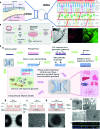Organoids and Microphysiological Systems: New Tools for Ophthalmic Drug Discovery
- PMID: 32317971
- PMCID: PMC7147294
- DOI: 10.3389/fphar.2020.00407
Organoids and Microphysiological Systems: New Tools for Ophthalmic Drug Discovery
Abstract
Organoids are adept at preserving the inherent complexity of a given cellular environment and when integrated with engineered micro-physiological systems (MPS) present distinct advantages for simulating a precisely controlled geometrical, physical, and biochemical micro-environment. This then allows for real-time monitoring of cell-cell interactions. As a result, the two aforementioned technologies hold significant promise and potential in studying ocular physiology and diseases by replicating specific eye tissue microstructures in vitro. This miniaturized review begins with defining the science behind organoids/MPS and subsequently introducing methods for generating organoids and engineering MPS. Furthermore, we will discuss the current state of organoids and MPS models in retina, cornea surrogates, and other ocular tissue, in regards to physiological/disease conditions. Finally, future prospective on organoid/MPS will be covered here. Organoids and MPS technologies closely recapture the in vivo microenvironment and thusly will continue to provide new understandings in organ functions and novel approaches to drug development.
Keywords: 3D tissue constructs; microphysiological system; ocular; organ-on-a-chip; organoid.
Copyright © 2020 Bai and Wang.
Figures

References
Publication types
LinkOut - more resources
Full Text Sources
Research Materials

